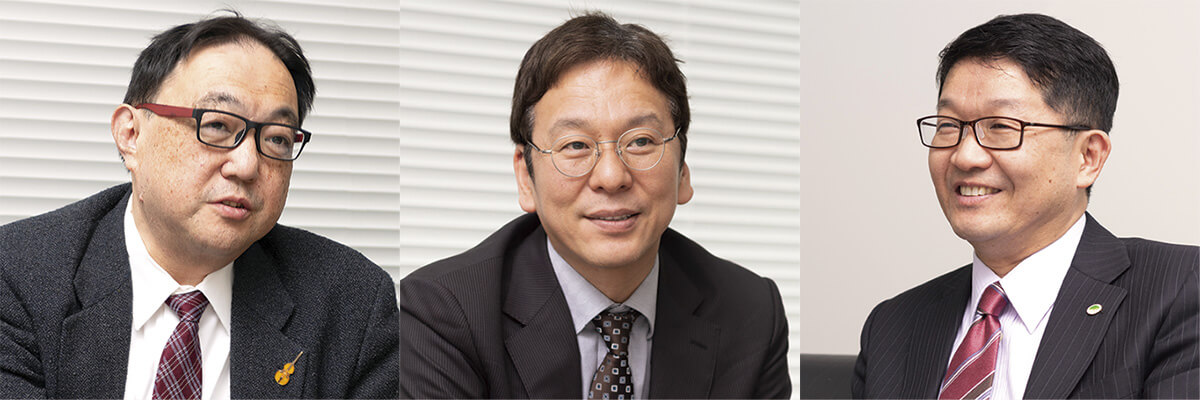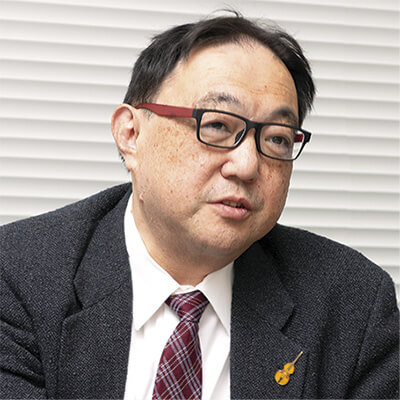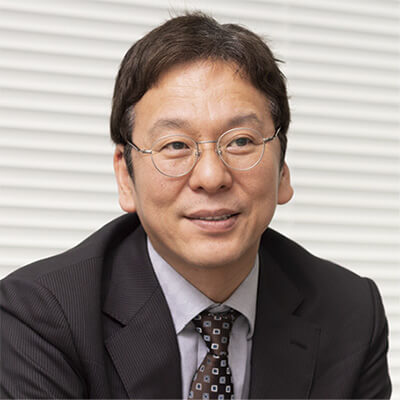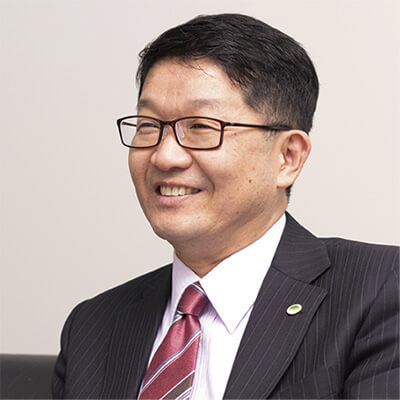COVER STORY:CONCEPTDigital Technology Transforming Energy SystemsManagement Based on Data Key to Successful Use of Renewable Energy
Highlight
The energy landscape is undergoing major changes, including an accelerating global trend toward decarbonized societies, the electrification of mobility and industrial machinery, and the increasing consumption of power by data centers driven by the advent of our data-driven society. With Japan’s energy markets also being buffeted by a wave of changes prompted by retail liberalization and other aspects of electricity system reform, there is also a growing trend toward the use of digital technology to build energy systems that are smarter and more resilient. How will digital technology transform the world of energy? What sort of energy systems can we expect in the near future? In this article, Hitachi Review invited Kiyoshi Nishimura, who is conversant with energy business strategy, and Yasuhiro Hayashi, known for his work on advanced energy systems, to discuss these questions.

Energy in a Once-in-a-century Period of Transition
 Kiyoshi Nishimura
Kiyoshi Nishimura
Specially Appointed Professor, Graduate School of Engineering, Osaka University
General Manager, Digital & DER, Kansai Electric Power Co., Inc.
After joining Kansai Electric Power Co., Inc., he worked in areas such as research, strategy, environment, and digital and DER utilization. He was a Special Visiting Professor on the Faculty of Economics, Gakushuin University from 1999 to 2001. His publications include “Denryoku Kaikaku no Kozu to Senryaku (Composition and Strategy of Electricity Reform)” (Energy-forum), and “Teitanso Shakai no Vision to Senryaku (Vision and Challenges of Low-carbon Society)” (co-authored, Koyo Shobo Corporation).
 Yasuhiro Hayashi
Yasuhiro Hayashi
Professor, Department of Electrical Engineering and Bioscience and Department of Advanced Science and Engineering, School of Advanced Science and Engineering, Waseda University
Graduated as a Doctor of Engineering from the Graduate School of Science and Engineering, Waseda University. Following positions as a lecturer at the Department of Systems Engineering, College of Engineering, Ibaraki University and associate professor at the Department of Electrical and Electronics Engineering, School of Engineering, University of Fukui, he was appointed to his current position in 2009. His role at Waseda University also includes the Director of the Research Institute for Advanced Network Technology and the Dean of the Advanced Collaborative Research Organization for Smart Society (ACROSS).
YamadaThe world of energy is experiencing great changes that include growing global momentum toward decarbonization and an acceleration in electrification and the installation of renewable energy. You are both familiar with the energy business and its technologies and policies. Can you please start by giving me your take on these developments in the sector?
NishimuraWhat we call the power system took on its completed form 100 years ago. The electricity business from the 1880s to the 1920s largely took the form of local production for local consumption. The template for the power system was provided by Nikola Tesla’s invention of the three-phase alternating current (AC) system, with the electricity market expanding rapidly in the 1920s in the aftermath of the First World War driven by the spread of electric lights and motors and the expansion of demand fueled by electrification. The power system developed further through economies of scale as equipment was expanded and scaled-up in response to increasing demand, while networks were given backup capacity to make them more reliable.
Meanwhile, along with the spread of renewable energy, technologies for stabilization and optimization began emerging about a decade ago using various equipment such as storage batteries on the electricity user side, where the network edge is, as well as techniques for grid stabilization based on the control of upstream power plants. This could be described as a once-in-a-century period of transition. It has led to the ongoing emergence of market-based arrangements to balance supply and demand instead of suppliers, with active electricity trading markets in places like Europe and the US state of California.
While Japan has been strengthening policy measures that focused on the use of demand-side resources and the establishment of new platforms, progress in this area means that the current power system dominated by large network systems looks like it will transform into a hybrid arrangement that coexists with distributed systems based on alternatives such as renewable energy and demand-side resources. In other words, a network system that allows renewable energy to be used at optimal points where it is most suited and that comprises the old system of supply-side control augmented by the new system of demand-side control. It seems to me we are at a point in time when everyone involved in energy needs to get together to figure out where to go next in anticipation of these changes.
HayashiIt certainly feels like we are in a period of great transition. In particular, prompted by the large planned outages and campaign to save power in the aftermath of the Great East Japan Earthquake, people have started looking at the need for ways of saving electricity that allow for monetization rather than asking for endurance in restraining consumption. Recent trends in the energy sector have been characterized as the “three Ds” of decarbonization, decentralization, and digitalization. Certainly, a major factor has been how the rapid advances in digitalization in particular have enabled data to provide a fine-grained view of the distributed flows of electric power, making it possible to establish practices that facilitate monetization at low cost. Those of us in the academic world have for some time made the case that an effective policy for energy-resource-poor Japan to save power would be to have some means whereby consumers, rather than simply going without energy, would be reimbursed by an amount commensurate with how much energy they have gone without. We now have the prerequisites in place for putting this into practice.
As Nishimura-san noted, rather than a one-way flow of electric power from upstream to downstream, the energy systems of the future will be made up of widely dispersed, distributed energy resources capable of three different types of action, namely to use, return, or store electric power. The key will be how digital technology is used to manage these systems.
Expectations for Smarter Electricity Networks
 Tatsuya Yamada
Tatsuya Yamada
Planning & Strategy Division, New Age Energy Business Co-create Division, Energy Business Administration Division Chief Lumada Officer, Energy Business Unit, Hitachi, Ltd.
Appointed to his current position in April 2019. He is currently engaged in collaborative creation projects in the energy sector, digital strategy formulation, and policy recommendation.
YamadaHitachi has made the Sustainable Development Goals (SDGs) a key axis of its management strategy. Likewise, achieving a sustainable society by improving social, environmental, and economic value through its Social Innovation Business is a pillar of its management plan. This involves seeking to boost these three different forms of value simultaneously, overcoming societal challenges such as the aging population and low birthrate, helping to address environmental problems such as climate change and the depletion of water and other resources, and improving corporate profitability. The keys to doing this lie in digital technology and the use of data. Hitachi is putting effort into energy as an area that is closely related to both environmental and social value, with the aim of utilizing digital technology and the use of data to overcome, for example, the issues that arise from greater use of renewable energy, a form of distributed generation, in the move to decarbonization.
HayashiIn the energy sector, it is smart meters*1 that make things possible when it comes to data. While the extent of their use varies by region, the plan is to have them fitted to all homes in Japan by 2024 and if that is accomplished the collection of data will become routine. I expect there will be worldwide interest in how we make use of this to generate value.
YamadaNishimura-san, you are well acquainted with how data is being used overseas.
NishimuraThere are considerable differences between countries. In the UK, for example, techniques for the analysis of smart meter data are well advanced and being used for applications such as marketing. While Japan is working to establish the legal framework for use of smart meter data, the 4-km mesh data from smart meters offers considerable social value beyond just the electricity business for uses like evacuation plans or urban planning. Such uses are something I would very much like to see.
First of all, providing a detailed view of energy flows and the ability to predict these will be essential to future power systems. As photovoltaic (PV) power generation increases, it will become too costly to continue with the current practice of relying on upgrades to distribution substations to deal with the voltage fluctuations caused by weather conditions or the time of day. Instead, management practices for reducing the load on the grid will be needed based on the alternative approaches discussed earlier. One trend in Europe is toward turning the likes of homes and factories into “prosumers.” It has well-established incentive schemes such as demand response (DR) to encourage measures for reducing the load on the grid, which means adjusting demand for electric power to match the available supply. Japan, too, will likely need ways of maintaining grid stability at as low a cost as possible to prepare itself for greater use of renewable energy in the future. It is anticipated that digital technology will support such enhancements to the electricity network.
- *1
- An electric power meter that digitally measures electricity usage to provide information on power consumption.
Expectations for New Business Creation and Digital Transformation
YamadaWe have mentioned some of the things we are looking for from data and the use of digital technology. My own New Age Energy Business Co-create Division is engaging in collaborative creation with a variety of customers to develop energy solutions and service businesses that use this technology. The Energy Business Unit is also making extensive use of the Lumada solution for accelerating digital innovation using the Internet of Things (IoT) and artificial intelligence (AI). One example of this is our plan for the global rollout of services such as energy management and a power grid solution that combines Lumada with the products and software of the power grid division of ABB Ltd. Given that high-added-value services and energy solutions that utilize data are set to be the growth sectors of the future, how are people in the electricity industry responding to the advance of digital technology and data use?
NishimuraWith digitalization being accompanied by ongoing decentralization, the truth is that the impact on electric utility revenues is negative due to an increasing number of competitors and the shrinking value of the electrical energy that has in the past provided the bulk of their income. There is hope, however, for new business development and cost innovation. New digital businesses can be grouped into four categories: household applications, industrial applications, data analysis and the IoT, and electric vehicle (EV) applications. One example of a potential business targeting households would be an aggregation service based on use of PV power and storage batteries. However, the deregulation of metering rules is crucial to the success of such endeavors. Photovoltaic power generation systems currently only meter reverse power flows for the purchase of excess power under the feed-in tariff (FIT) scheme. What is needed to enable initiatives such as the sale and purchase of environmental value and aggregation businesses to proceed is both the use of digital technology and regulatory reform to enable the simple and low-cost metering of total generation, such as the provision being incorporated into this year’s proposed amendments to the Electricity Business Act that permits measurement by means other than strictly certified meters. Other examples include industrial applications such as more sophisticated energy management and peak management, IoT applications such as the development of services based on the analysis of energy data and combined analysis of this data with non-energy data, and EV applications such as sharing services or the use of EVs as storage batteries to balance supply and demand. While all of these sectors must deal with risks, with each facing barriers in the form of equipment prices, market conditions, and the regulatory framework, nevertheless we too have already started on business development with a view to the future.
HayashiAs for equipment prices, these are likely to fall with increasing demand. Another consideration that is perhaps specific to Japan with our high prevalence of disasters is that PV power generation systems and EVs play a role not only in decarbonization, but also in boosting resilience. I understand that installation of home PV power generation and storage batteries skyrocketed in the aftermath of 2019’s Typhoon No. 19, Hagibis. As for the regulatory framework, we can expect progress from the various reform initiatives currently underway at the Agency of Natural Resources and Energy and elsewhere. These relate to the post-FIT regime and use of data as well as metering.
As for what the energy industry hopes to accomplish with digital technology, I believe this includes business innovation achieved through digital transformation. I expect they are also interested in the solutions offered by Hitachi.
YamadaWhile these are mainly focused on workplace applications for now, being limited to piecemeal digital solutions for the likes of maintenance cost optimization and labor saving, our plan for the future involves expanding into operational applications such as improving the efficiency of electricity transmission and distribution.
Need for Open and Secure Platforms
YamadaGiven that ongoing decentralization and the emergence of more “prosumers” will increase the number of market players, an acceleration is anticipated away from a hardware-centric focus to a reorientation toward platforms as various forms of data are put to use in ways that transcend regional boundaries.
NishimuraWhile transmission and distribution platforms are well defined, the problems lie in service platforms. It will be important to establish an environment that makes it easy for new players to enter the market, one that will serve as a basis for delivering a wide range of services, including the operation and management of electrical infrastructure, energy management, trading by retailers and aggregators*2, and transactions with distribution system operators (DSOs) and transmission system operators (TSOs). Electricity utilities in Europe have started work on putting platforms in place out of a sense of urgency, recognizing that their survival is at stake should they fail to make the transition to the world of customer-oriented service businesses.
YamadaWhile you are seeking to establish a platform in the market for supply and demand balancing where Hitachi’s role involves assisting with system development, I expect similar moves will also be needed in the service arena.
HayashiBecause energy platforms constitute an essential service, reliability is of high importance. At the same time, the platform needs to be open to a wide range of market participants. To achieve this, I also believe that the energy industry needs to establish an organization to look at the question of platforms where we can get together to map out a grand design. The idea would be to create a situation in which all of the transmission and distribution network operators demonstrate a sense of presence while the DSOs who are full of ideas go about expanding their service businesses.
Standardization also has an important role to play in the exchange of data and information across platforms. Right now, just making connections is difficult.
NishimuraThat’s right. What we have discovered from our several years of work on virtual power plants (VPPs)*3 at Kansai Electric Power, is that even with the OpenADR 2.0 international standard protocol for automatic DR, getting the different devices to talk to one another has taken a lot of effort because each implements the standard in its own way. While standardization is an intricate matter, it is an important consideration.
YamadaOpen data is also important for making use of data. There have been initiatives such as the Grid Data Bank Lab. set up to promote use of data and smart meters and other electrical equipment around the country, and innovation should also be encouraged when it is possible for various different players to access grid data as well as data from smart meters without compromising security.
NishimuraWhen it comes to security, I expect it is important to have fine control over to whom and to what extent there should be open access to data.
- *2
- Businesses that stand between utilities and consumers and balance the supply and demand for electric power through the control of demand-side consumption.
- *3
- The consolidated control of a large number of generators and power systems so as to treat them as a single power plant.
Hints for Future Energy from Japan
YamadaFinally, where do you see things going with energy in the near future?
HayashiWhile it goes without saying that decarbonization is a major trend, I also believe that fostering the expansion of the VPP market will be important in terms of what happens with this in the near future. At the Advanced Collaborative Research Organization for Smart Society (ACROSS) of which I serve as Dean at Waseda University, we are working from an academic standpoint to expand the use of VPPs, having received funding from the Sustainable open Innovation Initiative for a project to establish VPP infrastructure. Making use of market principles is key to speeding up decarbonization and the adoption of smart practices, and innovation should be accelerated by establishing an environment that can monetize the work of the aggregators engaged in the market-based balancing of supply and demand. In this respect, Kansai Electric Power’s establishment of an integrated platform to support VPP operation is laudable work.
NishimuraIt seems we are at a time when the power companies themselves need to take up the challenge of reform.
HayashiThe impact on society will be great once VPPs reach a scale where they can substitute for entire power plants. What with SDGs and environment, social, and governance (ESG) investment, it seems that businesses and capital flows are moving in the direction of decarbonization regardless. How best to manage changing energy systems makes for an interesting topic of research.
NishimuraSomething I often say to my students in class is that the percentage of the global population that lives in cities, currently around 30%, is expected to reach 50% by 2050 to 2060. In other words, I ask them what sort of energy networks will suit societies in which the majority of people live in urban areas? As the global population surpasses 10 billion and society achieves a degree of maturity, shifting away from mass consumption, won’t this bring major changes in the form of energy systems?
It is likely that the energy world will see something similar to the leapfrog effect*4 that has occurred with telecommunications in emerging nations, where the spread of mobile phones has proceeded ahead of fixed-line networks. There is also a company called WASSHA Inc. that installs PV panels in off-grid parts of Africa and offers a mobile phone recharging and lantern rental service. This is a case of the benefits of energy arriving in advance of a transmission and distribution infrastructure. I believe the future of energy lies somewhere between the world of legacy systems like those in developed nations and that of solar and lanterns.
Decentralized networks may become the de facto standard, for example, and though it is not currently possible, autonomous grids could even become the norm should an inverter be devised that serves a similar role to rotating machines. We need to think about the future of energy in these global terms. If possible, I also hope that we in Japan can be a source of technologies and businesses that will provide the world with hints for the future of energy.
YamadaUnderpinning future-directed joint initiatives by industry and academia, my impression is that reform is accelerating with the government, especially the Agency of Natural Resources and Energy of the Ministry of Economy, Trade and Industry, pushing ahead with things like deregulation. Meanwhile, with all of your help, we at Hitachi will also contribute through our business to the development of the energy systems that will support a sustainable society. Thank you for your time today.
- *4
- A sudden expansion of new services that occurs when emerging nations lacking in existing social infrastructure bypass the path of technical progress followed by developed nations.





